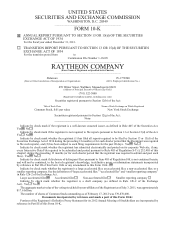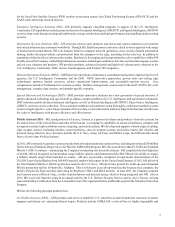Raytheon 2011 Annual Report Download - page 17
Download and view the complete annual report
Please find page 17 of the 2011 Raytheon annual report below. You can navigate through the pages in the report by either clicking on the pages listed below, or by using the keyword search tool below to find specific information within the annual report.9
U.S. Government contracts generally are subject to the Federal Acquisition Regulation (FAR), which sets forth policies,
procedures and requirements for the acquisition of goods and services by the U.S. Government, department-specific regulations
that implement or supplement FAR, such as the DoD's Defense Federal Acquisition Regulation Supplement (DFARS), and
other applicable laws and regulations. These regulations impose a broad range of requirements, many of which are unique to
government contracting, including various procurement, import and export, security, contract pricing and cost, contract
termination and adjustment, and audit requirements. A contractor's failure to comply with these regulations and requirements
could result in reductions to the value of contracts, contract modifications or termination, and the assessment of penalties and
fines and lead to suspension or debarment, for cause, from government contracting or subcontracting for a period of time. In
addition, government contractors are also subject to routine audits and investigations by U.S. Government agencies such as
the Defense Contract Audit Agency (DCAA) and Defense Contract Management Agency (DCMA). These agencies review a
contractor's performance under its contracts, cost structure and compliance with applicable laws, regulations and standards.
The DCAA also reviews the adequacy of and a contractor's compliance with its internal control systems and policies, including
the contractor's purchasing, property, estimating, compensation and management information systems. For a discussion of
certain risks associated with compliance with U.S. Government contract regulations and requirements, see Item 1A “Risk
Factors” of this Form 10-K.
U.S. Government contracts include both cost reimbursement and fixed-price contracts. Cost reimbursement contracts, subject
to a contract-ceiling amount in certain cases, provide for the reimbursement of allowable costs plus the payment of a fee.
These contracts fall into three basic types: (i) cost plus fixed fee contracts which provide for the payment of a fixed fee
irrespective of the final cost of performance, (ii) cost plus incentive fee contracts which provide for increases or decreases in
the fee, within specified limits, based upon actual cost results compared to contractual cost targets, and (iii) cost plus award
fee contracts which provide for the payment of an award fee determined at the discretion of the customer based upon the
performance of the contractor against pre-established criteria. Under cost reimbursement type contracts, the contractor is
reimbursed periodically for allowable costs and is paid a portion of the fee based on contract progress. Some costs incident
to performing contracts have been made partially or wholly unallowable for reimbursement by statute, FAR or other regulation.
Examples of such costs include charitable contributions, certain merger and acquisition costs, lobbying costs, interest expense
and certain litigation defense costs.
Fixed-price contracts are either firm fixed-price contracts or fixed-price incentive contracts. Under firm fixed-price contracts,
the contractor agrees to perform a specific scope of work for a fixed price and as a result, benefits from cost savings and carries
the burden of cost overruns. Under fixed-price incentive contracts, the contractor shares with the government savings accrued
from contracts performed for less than target costs and costs incurred in excess of targets up to a negotiated ceiling price
(which is higher than the target cost) and carries the entire burden of costs exceeding the negotiated ceiling price. Accordingly,
under such incentive contracts, the contractor's profit may also be adjusted up or down depending upon whether specified
performance objectives are met. Under firm fixed-price and fixed-price incentive type contracts, the contractor usually receives
either milestone payments equaling up to 90% of the contract price or monthly progress payments from the government
generally in amounts equaling 80% of costs incurred under government contracts. The remaining amount, including profits
or incentive fees, is billed upon delivery and acceptance of end items under the contract. Through recent initiatives, the DoD
has expressed a preference to utilize progress payments based on costs incurred on new fixed-price contract awards as opposed
to performance-based payments (PBPs) unless the contractor negotiates for PBPs. Generally speaking and subject to a number
of factors, PBPs can provide improved cash flows as compared to progress payments but introduce risk to contractors in return.
In the event we experience a greater proportion of progress payments for our fixed-price DoD contracts in the future than
historically, it could have an adverse affect on our operating cash flow and liquidity. For a discussion of certain risks associated
with fixed price and cost reimbursement contracts and risks associated with changes in U.S. Government procurement rules,
regulations and business practices, see Item 1A “Risk Factors” of this Form 10-K.
U.S. Government contracts generally also permit the government to terminate the contract, in whole or in part, without prior
notice, at the government's convenience or for default based on performance. If a contract is terminated for convenience, the
contractor is generally entitled to payments for its allowable costs and will receive some allowance for profit on the work
performed. If a contract is terminated for default, the contractor is generally entitled to payments for its work that has been
accepted by the government. The U.S. Government's right to terminate its contracts has not had a material adverse effect upon
our operations or financial condition. For a discussion of the risks associated with the U.S. Government's right to terminate
its contracts, see Item 1A “Risk Factors” of this Form 10-K.
























